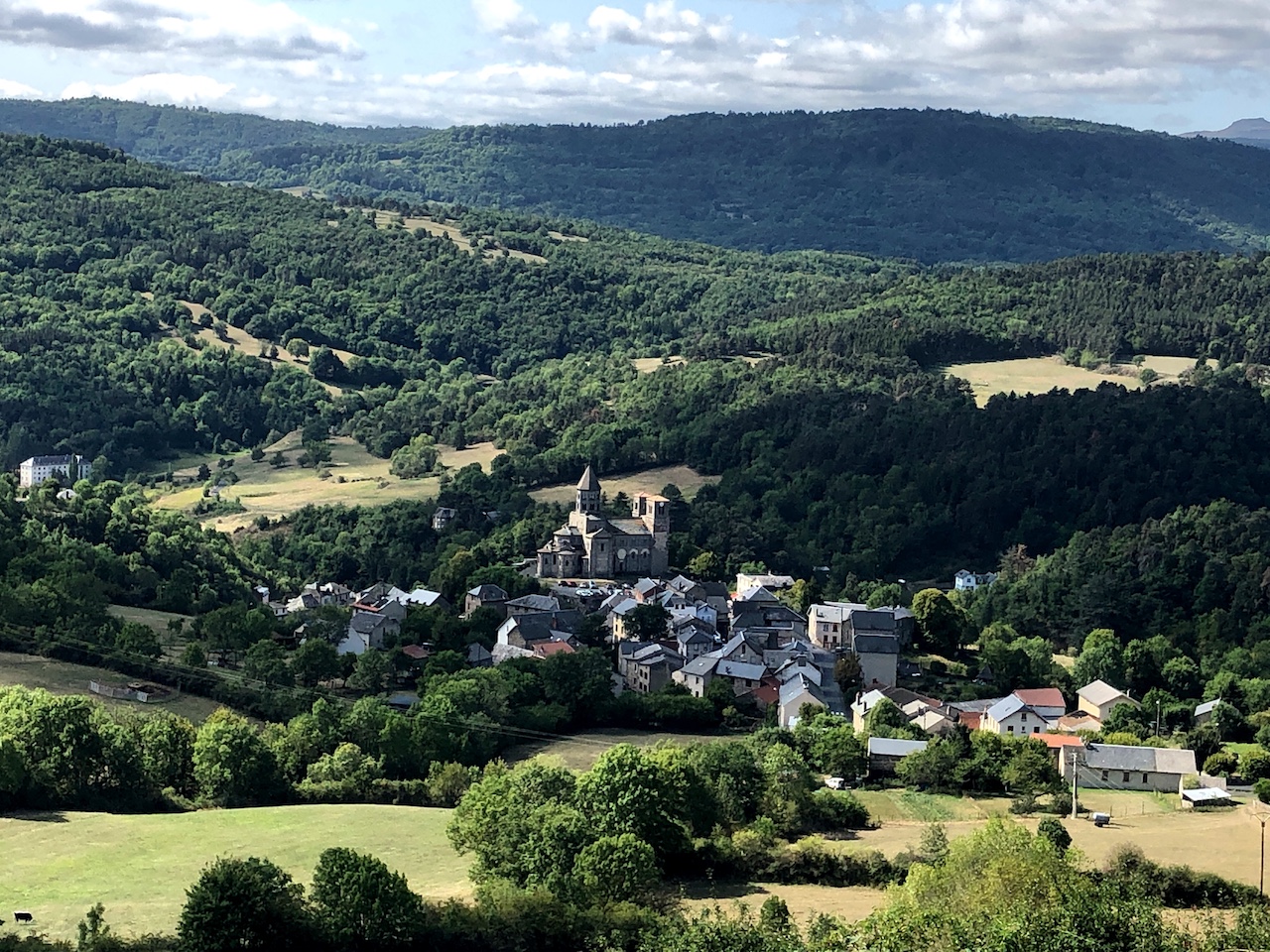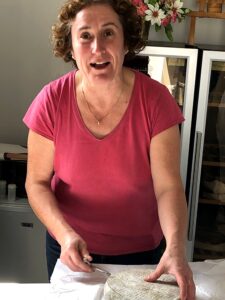Icame to Saint-Nectaire for the cheese.
While passing through the Auvergne region of south-central France recently, I was determined to see the village from which this nutty-flavored semi-soft cheese got its name, and to buy a wheel of it from one of the producers. While the former was easily accomplished, the latter required going out of town, to the farms that together churn out 6,500 tons of Saint-Nectaire annually.
To do that, my husband and I stopped at an in-town tourist establishment, breezed by the tour group that was there for a tasting and picked up a free copy of the Carte de la Route des Fromages AOP d’Auvergne. It’s an excellent map of the local farms that open their doors to visitors like us and sell directly to the public. A brown marker pointing out of Saint-Nectaire directed us to the Route des Fromages (cheese route), with 37 different producers noted.
While some devote themselves exclusively to Saint-Nectaire, others offer additional cheeses that are a specialty of this region: Cantal (a cow’s milk cheese thought to be a precursor to cheddar); Salers, which is similar to Cantal but stronger; and two types of blue cheese – fourme d’Ambert and bleu d’Auvergne. Icons on the map cue you to who sells what.
By following the Route des Fromages one quickly understands why the Auvergne is such a vibrant cheese-producing region. The soil is enriched by volcanoes, visible in the distance. Cows grazing in nearby prairies are eating not only grass but also herbs and wildflowers. The French call the result terroir – the flavor that foods (and wines) derive from the soil, atmosphere, weather and other factors associated with their production.
Though many French cheeses have been produced for centuries, in modern history a system of standardization has emerged throughout Europe. It’s called AOP, which is an acronym for appellation d’origine protégée (protected designation of origin), and it controls how agricultural products from particular regions are labeled.
With cheese it means they must meet criteria regarding the type of cows; how they are fed; and how the cheese is produced at each stage. Only cheese that meets the specified criteria are allowed to carry the AOP label – a red-and-yellow starburst.
To help educate consumers, Saint-Nectaire has its own trade association and a Facebook page with (at last count) nearly 17,000 followers. According to its AOP website, the cheese has been around since the 17th century, when Maréchal Henry de Sennecterre introduced it on the table of Louis XIV. Saint-Nectaire got an AOP designation in 1955, and in 2017 accounted for the highest volume of a single farm cheese produced in Europe.
By AOP rules, cows involved in the production of Saint-Nectaire must be bred and raised in the mountains around Puy-de-Dôme and Cantal, and live what to me sounds like a somewhat pampered life. Not only must they not be crowded in their grazing conditions, but they must also spend at least 160 days a year in the pasture. Their diet needs to come from at least 90% of natural prairie material. And to the extent that they ingest cow feed, it must consist exclusively of local vegetation.
Thus informed, and practically salivating for prairie grass, we pinpointed the village of Beaune le Froid along the Route des Fromages, where four different producers are situated, hoping to find at least one of them open. We were just being practical: Many places in rural France close for several hours at lunchtime. Add to that the routine Sunday closings, along with weekday morning or afternoon shutterings, all of which vary from one establishment to the next, and we are always half-prepared to be greeted with a sign that says ferme (closed).
Fortunately for us, that was not the case on a September Thursday shortly before noon when we pulled up outside the barn on the rue des Bruyères belonging to Monsieur and Madame Eric Pons. They were just saying au revoir to a couple of European tourists who departed, all smiles, carrying packages of what were obviously wheels of Saint-Nectaire. Regional cheeses are a favorite souvenir of French vacationers, and they do not hesitate to make bulk purchases.
I had in mind a smaller quantity. But non, explained Chovert Pons, the cheery proprietress, this would not be possible. They sold only wheels, which cost €17 ($18.83 at current conversion rates) and, by my rough estimate, weighed several pounds. Madame Pons did not give me a hard sell for the soft cheese. Instead, she let me know that in the nearby village of Murol, there was a store that would cut me a slice.
I looked longingly at the flat round wheel on the table between us, measuring roughly eight inches in diameter and one and one-half inches thick. She brushed her hand proudly over its gray-brown rind as if she was petting a cat. Might I have a taste? This is customary in cheese stores, but I wondered if a different protocol applied down on the farm.
She very willingly obliged, using a tool called a sonde, which drilled into the center of the cheese to extract a slender, creamy, smooth ivory sample. With one end of it, Madame Pons plugged the hole that she had just made in the cheese. Then she held out the sonde, motioning for me to peel off the rest of the boring.
This four-week-old Saint-Nectaire tasted vaguely of straw and juniper berries and buttercups. Or maybe it was just the power of ambiance. The owners have been in this business for eight generations and, according to family lore, age their Saint-Nectaire in a cave that dates to the 13th or 14th century. Whether the cheese or these details were more delicious might be a toss-up.
Either way, I left with my very own wheel of it to eat, for as long as it lasts, as I travel through France. Madame Pons advised me to cut it in fourths, work on one-quarter at a time, and freeze the rest, wrapped in cellophane, in a Ziploc bag. At the various houses we have rented, I will have the opportunity to do that, and to follow Madame Pons’s instructions for defrosting: As it thaws, wipe off any ice that has formed. Moisture is not good for the cheese.
She locked the barn door behind us. It was lunchtime and her farm, according to the posted schedule, happened to be closed that afternoon. But just up the road, a sign pointed to cheese caves that are eternally open. These are not currently in use; to visit ones that contain ripening cheese would violate 21st-century hygiene standards. But in a cave quite like these abandoned structures, burrowed into the volcanic rock, my wheel of Saint-Nectaire had presumably ripened.
As Madame Pons predicted, the Saint-Nectaire froze well, and I was still working on that wheel of it when I stopped by the village butcher shop at our next destination, in the Périgord region. After a conversation with the owner about the local cooperative where he sources his magret (duck breast), I called attention to the Auvergne cheeses in the store’s display case. Then I told him that I had bought Saint-Nectaire in Saint-Nectaire. He grinned broadly and said with a chuckle, “Ah, c’est obligatoire!”
Deborah L. Jacobs is the author most recently of the five-time award winning book, Four Seasons in a Day: Travel, Transitions and Letting Go of the Place We Call Home, about her adventures – and misadventures – living in France. Follow her on Twitter at @djworking and join her on Facebook here. You can subscribe to future blog posts by using the sign-up box on her website’s homepage.
RELATED POSTS
Sniffing Out a Restaurateur’s Cheesemonger
The Whole Bonito on Budget Travel
 Rich volcanic soil and grazing conditions around Saint-Nectaire give the cheese its unique flavor.
Rich volcanic soil and grazing conditions around Saint-Nectaire give the cheese its unique flavor.
Another great story that makes me lust for French cheese!